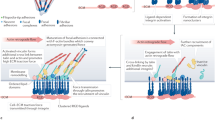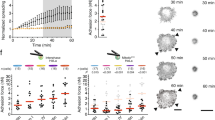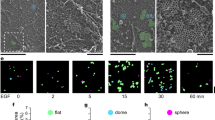Abstract
Integrins are important mediators of cell adhesion to extracellular ligands and can transduce biochemical signals both into and out of cells1,2. The cytoplasmic domains of integrins interact with several structural and signalling proteins and consequently participate in the regulation of cell shape, motility, growth and differentiation3. It has been shown that calreticulin associates with the cytoplasmic domains of integrin α-subunits and that this interaction can influence integrin-mediated cell adhesion to extracellular matrix4,5. We have now developed calreticulin-deficient embryonic stem (ES) cells and isolated embryonic fibro-blasts from calreticulin mutant mice. We find that in both cell types integrin-mediated adhesion is severely impaired, although integrin expression is unaltered. Expression of recombinant calreticulin in double knockout ES cells by complementary DNA transfection rescued integrin-mediated adhesion. In wild-type cells, engagement of surface integrins induced a transient elevation in cytosolic calcium concentration owing to influx of extracellular calcium. This calcium transient was absent in calreticulin-deficient cells. In contrast, the amount of calcium in endomembrane stores, which is sensitive to both inositol 1,4,5-trisphosphate and thapsigargin, was indistinguishable in the two cell types. Our results indicate that calreticulin is an essential modulator both of integrin adhesive functions and integrin-initiated signalling, but that it may not play a significant role in the storage of luminal calcium.
This is a preview of subscription content, access via your institution
Access options
Subscribe to this journal
Receive 51 print issues and online access
$199.00 per year
only $3.90 per issue
Buy this article
- Purchase on Springer Link
- Instant access to full article PDF
Prices may be subject to local taxes which are calculated during checkout
Similar content being viewed by others
References
Hynes, R. O. Integrins: versatility, modulation, and signalling in cell adhesion. Cell 69, 11–25 (1992).
Schwartz, M. A., Schaller, M. D. & Ginsberg, M. H. Integrins: Emerging paradigms of signal transduction. Annu. Rev. Cell Biol. and Dev. Biol. 11, 549–600 (1995).
Dedhar, S. & Hannigan, G. E. Integrin cytoplasmic interactions and bidirectional transmembrane signalling. Curr. Opin. Cell Biol. 8, 657–669 (1996).
Coppolino, M. G. et al. Inducible interaction of integrin α2β1 with calreticulin: dependence on the activation state of the integrin. J. Biol. Chem. 270, 23132–23138 (1995).
Leung-Hagesteijn, C. et al. Cell attachment to extracellular matrix substrates is inhibited upon downregulation of expression of calreticulin, an intracellular integrin α-subunit-binding protein. J. Cell. Sci. 107, 589–600 (1994).
Mansour, S. L. Disruption of the proto-oncogene int-2 in mouse embryo-derived stem cells: a general strategy of targeting mutations to non-selectable genes. Nature 336, 348–352 (1988).
Capecchi, M. The new mouse genetics: altering the genome by gene targeting. Trends Genet. 5, 70–76 (1989).
Michalak, M. et al. Calreticulin. Biochem. J. 285, 681–692 (1992).
Camacho, P. & Lechleiter, J. D. Calreticulin inhibits repetitive intracellular Ca2+ waves. Cell 82, 765–771 (1995).
Mery, L. et al. Overexpression of calreticulin increases intracellular Ca2+ -storage and decreases store-operated Ca2+ influx. J. Biol. Chem. 271, 9332–9339 (1996).
von Tscharner, V., Deranleau, D. A. & Baggioloni, M. Calcium fluxes and calcium buffering in human neutrophils. J. Biol. Chem. 261, 10163–10168 (1986).
Jalink, K. et al. Lysophosphatidic acid-induced Ca2+ mobilization in human A431 cells: structure-activity analysis. Biochem. J. 307, 609–616 (1995).
Liu, N. et al. Decreasing calreticulin expression lowers the Ca2+ response to bradykinin and increases sensitivity to ionomycin in NG-108-15 cells. J. Biol. Chem. 269, 28635–28639 (1994).
Bastianutto, C. et al. Overexpression of calreticulin increases the Ca2+ capacity of rapidly exchanging Ca2+ stores and reveals aspects of their lumenal microenvironment and function. J. Cell Biol. 130, 847–855 (1995).
Schwartz, M. A. Spreading of human endothelial cells on fibronectin or vitronectin triggers elevation of intracellular free calcium. J. Cell Biol. 120, 1003–1010 (1993).
Sjaastad, M. D., Lewis, R. S. & Nelson, W. J. Mechanisms of integrin-mediated calcium signaling in MDCK cells: regulation of adhesion by IP.3- and store-independent calcium influx. Mol. Biol. Cell 1, 1025–1041 (1996).
Dedhar, S. Novel functions for calreticulin: interaction with integrins and modulation of gene expression? Trends Biochem. Sci. 19, 269–271 (1994).
Sontheimer, R. D. et al. The unveiling of calreticulin—a clinically relevant tour of modern cell biology. J. Invest. Med. 43, 362–370 (1995).
Rojiani, M. V. et al. In vitro interaction of a polypeptide homologous to human RO/SS-A antigen (calreticulin) with a highly conserved amino-acid sequence in the cytoplasmic domain of integrin α-subunits. Biochemistry 30, 9859–9866 (1991).
Williams, M. J. et al. The inner world of cell adhesion: integrin cytoplasmic domains. Trends Cell Biol. 4, 109–112 (1994).
Opas, M. et al. Calreticulin modulates cell adhesiveness via regulation of vinculin expression. J. Cell Biol. 135, 1913–1923 (1996).
Burns, K. et al. Modulation of gene expression by calreticulin binding to the glucocorticoid receptor. Nature 367, 476–480 (1994).
Dedhar, S. et al. Inhibition of nuclear hormone receptor activity by calreticulin. Nature 367, 480–483 (1994).
St Arnaud, R. et al. Constitutive expression of calreticulin in osteoblasts inhibits mineralization. J. Cell Biol. 131, 1351–1359 (1995).
McCauliffe, D. P. et al. Molecular cloning, expression, and chromosome 19 localization of a human Ro/SS-A autoantigen. J. Clin. Invest. 86, 332–335 (1990).
Rudnicki, M. A. et al. Inactivation of MyoD in mice leads to upregulation of the myogenic HLH gene myf-5 and results in apparently normal muscle development. Cell 71, 383–390 (1992).
Hogan, B. Manipulating the Mouse Embryo (Cold Spring Harbor Laboratory Press, New York, 1994).
Mortensen, R. M. Production of homozygous mutant ES cells with a single targeting construct. Mol. Cell. Biol. 12, 2391–2395 (1992).
Miyake, K. et al. Evidence for a role of the integrin VLA-4 in lympho-hemopoiesis. J. Exp. Med. 173, 599–607 (1991).
Author information
Authors and Affiliations
Rights and permissions
About this article
Cite this article
Coppolino, M., Woodside, M., Demaurex, N. et al. Calreticulin is essential for integrin-mediated calcium signalling and cell adhesion. Nature 386, 843–847 (1997). https://doi.org/10.1038/386843a0
Received:
Accepted:
Issue Date:
DOI: https://doi.org/10.1038/386843a0
This article is cited by
-
Calreticulin: a quintessential multifaceted protein with therapeutic potential
Journal of Proteins and Proteomics (2023)
-
Integrin α3β1 promotes vessel formation of glioblastoma-associated endothelial cells through calcium-mediated macropinocytosis and lysosomal exocytosis
Nature Communications (2022)
-
Calreticulin and cancer
Cell Research (2021)
-
Thrombospondin-3 augments injury-induced cardiomyopathy by intracellular integrin inhibition and sarcolemmal instability
Nature Communications (2019)
-
Cardiac-derived CTRP9 protects against myocardial ischemia/reperfusion injury via calreticulin-dependent inhibition of apoptosis
Cell Death & Disease (2018)
Comments
By submitting a comment you agree to abide by our Terms and Community Guidelines. If you find something abusive or that does not comply with our terms or guidelines please flag it as inappropriate.



